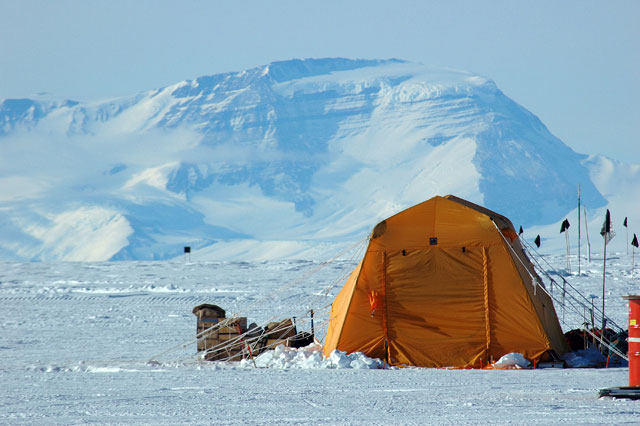Return of the dinosaur (hunters)Paleontologists continue 20-year recovery of carnivore, discover new fossilsPosted April 15, 2011
Paleontologists working on a high peak in the central Transantarctic Mountains have recovered more than half of the fossils belonging to the first dinosaur found in Antarctica — 20 years after its initial discovery. And the unearthing of yet two new Early Jurassic dinosaur species near the top of 4,528-meter-high Mount Kirkpatrick promises to keep scientists busy for years to come preparing and describing the important finds. William Hammer “In 90-91, we didn’t know what we had except that it had to be entirely new because it was the first dinosaur,” said Hammer, who returned to the Beardmore region for a third time with his largest team to date in an effort to recover as much of the meat-eating dinosaur as possible. “It will be one of the most, if not the most, complete predator from the Early Jurassic that we have. It will be quite an impressive specimen,” said Peter Makovicky Among the new discoveries is the partial skeleton of an ornithischian, or bird-hipped dinosaur, found under an overhang near the Cryolophosaurus quarry by Roger Smith The ornithischia, an extinct herbivore, gets its name from its bird-like hip structure, though birds did not descend from this particular order of dinosaurs. The order includes the genus of the well-known stegosaurus, which emerged in the late Jurassic. Like Cryolophosaurus, the ornithischian specimen also dates to the Early Jurassic, about 200 to 175 million years ago. In addition, bits of a pelvis bone belonging to a dinosaur in the order saurischia (lizard-hipped) from the Early Jurassic were found quite by accident when loose pieces rolled downhill by one of the team members. The remainder of the hip bone was excavated a few days later. Making his first trip to the Antarctic, Makovicky said there are few places in the world where paleontologists can expect to recover such early remains of dinosaurs. “It’s not a well-represented time slice in terms of diversity, especially compared to the Late Cretaceous, which is much better known for its dinosaur diversity around the world,” he said, referring to a time period between 100 and 65 million years ago when dinosaurs were enjoying great success — before their sudden extinction at the end of the Cretaceous. Makovicky said such a complete, early skeleton becomes invaluable for studying other specimens — a sort of paleontological Rosetta Stone. “That specimen becomes key, or a guiding specimen, for interpreting the anatomy of more fragmentary dinosaurs we may have from elsewhere,” he explained. “That’s why digging up every possible bone becomes very critical.” The opportunity to work on the Cryolophosaurus excavation enticed Philip Currie “If you’re interested in the evolution and relationships of dinosaurs, then you pretty much have to look at the early dinosaurs as well,” Currie said. Currie often works at Dinosaur Provincial Park |
"News about the USAP, the Ice, and the People"



For USAP Participants |
For The Public |
For Researchers and EducatorsContact UsU.S. National Science FoundationOffice of Polar Programs Geosciences Directorate 2415 Eisenhower Avenue, Suite W7100 Alexandria, VA 22314 Sign up for the NSF Office of Polar Programs newsletter and events. Feedback Form |



